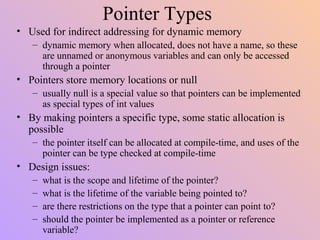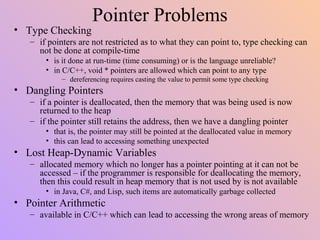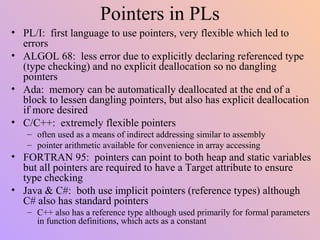This document discusses different data types used in programming languages. It covers primitive data types implemented directly in hardware like integers and floating point numbers. It also discusses common composite types like strings, arrays, records, and enumerations. The document examines how various programming languages have implemented and extended these basic types over time to provide more powerful abstractions.
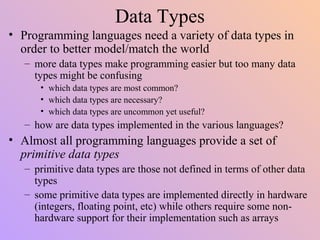







![Indexes
• Index maps array element to memory location
– early languages did no run-time range checking, but range-checking is done
in most modern languages for reliability
• Array indexes are usually placed in some syntactic unit
– [ ] in most languages: Pascal, Modula-2, C-languages
– ( ) in FORTRAN, PL/I, Ada
• parens weaken readability because something like foo(x) is now hard to read – is
it a subroutine call or an array access?
– Lisp uses a function as in (aref array 6) to mean array[6]
• Most languages separate dimensions by ,
– but C-languages use [ ][ ]
• Two types associated with arrays that need to be declared
– the type of value being stored
– the type of value used for an index (in Pascal-like languages)
• Are lower bounds automatically set?
– C/C++, Java, early FORTRAN use 0
– 1 is used in later FORTRANs
– explicit in all other languages](https://image.slidesharecdn.com/ch6-160424130107/85/Ch6-9-320.jpg)




![Array Implementations
• Arrays are almost always a contiguous block of memory equal to
the size needed to store the array
– each successive array element is stored in the next memory location
• We define a mapping function which translates the array indexes
to the memory location, for instance a 1-D array in C maps as
– a[i] = OFFSET + i * length
• OFFSET is the starting point of the array and length is the size in bytes of
each element
• if the language has a lower bound of 1, then we change the above to be (i – 1)
• Multi-dimensional arrays in C-languages are altered to include
the memory used by all previous rows:
a[i][j] = OFFSET + i * n * length + j * length
That is, the array element at [i, j] has i previous rows of n
(including row 0) items each, and j elements in the current row
More generically, for languages that allow for a non-0 lower
bound, we would use a[i, j] = OFFSET + (i – loweri) * n *
length + (j – lowerj) * length](https://image.slidesharecdn.com/ch6-160424130107/85/Ch6-14-320.jpg)
![More on Mapping
• Most languages use row-major order
– in row-major order, all of row i is placed consecutively,
followed by all of row i+1, etc.
• FORTRAN is the only common language to instead use column-major
order (see pages 274-275 for example)
– we don’t have to know whether a language uses row-major or
column-major order when writing our code
• but we could potentially write more efficient code when dealing with
memory management and pointer arithmetic if we did know
• With multi-dimensional arrays (beyond 2), the mapping
function is just an extension of what we had already seen
– for a 3-d array a[m][n][p], we would use:
• a[i, j, k] = OFFSET + i*n*length + j*m*length + k*length
– this formula will not work if we are dealing with jagged arrays](https://image.slidesharecdn.com/ch6-160424130107/85/Ch6-15-320.jpg)
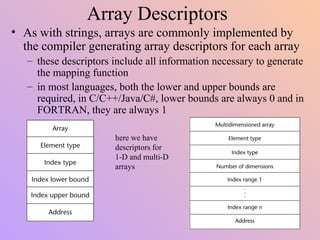
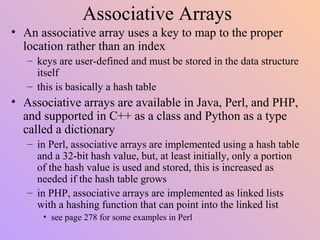


![Record Implementation
• Similar to Arrays, requires a mapping function
– since fields are statically defined, mapping function is determined at
compile-time
– example:
type Foo is record
name : String(1..10);
sex : char;
salary : float;
end record;
If a variable, x, of type Foo starts at offset, then
x.name = offset
x.sex = offset + 10
x.salary = offset + 11
If we have an array a of Foo starting at index 0, then
a[i].name = offset + 12 * i
a[i].sex = offset + 12 * i + 10
a[i].salary = offset + 12 * i + 11
A generic
compile-time
descriptor for
a record is
given to the right](https://image.slidesharecdn.com/ch6-160424130107/85/Ch6-20-320.jpg)




